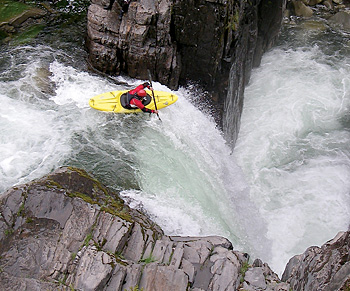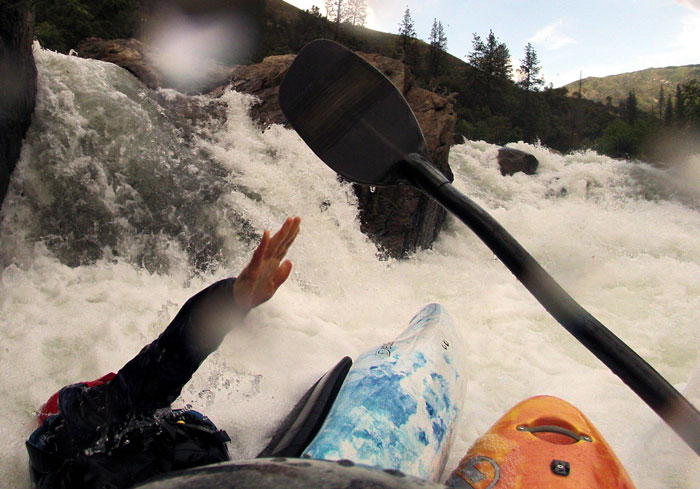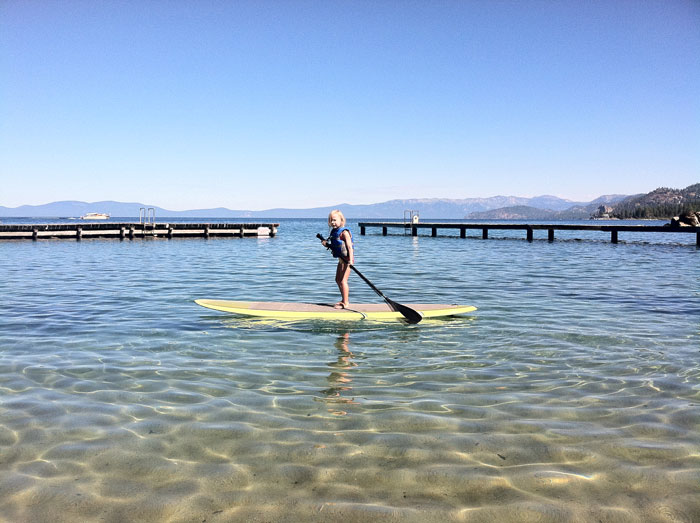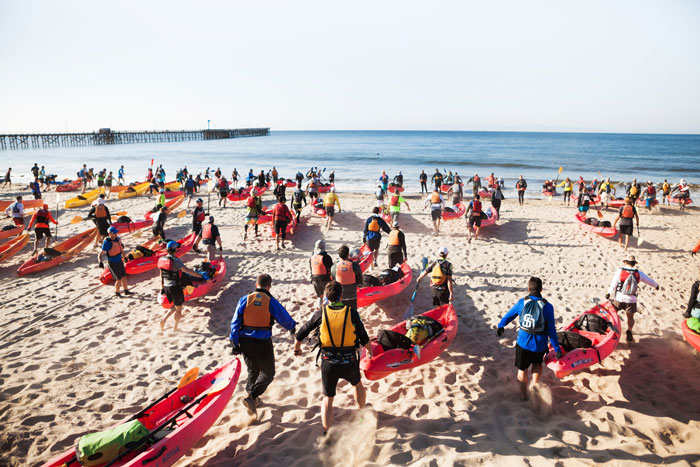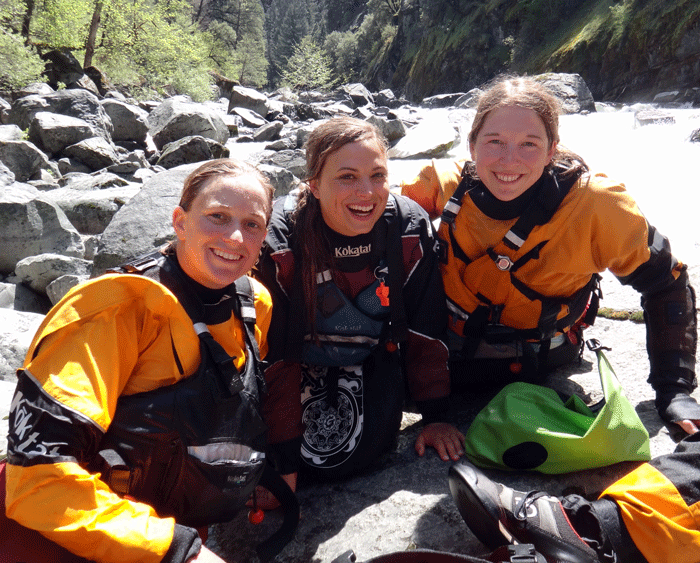- Tahoe’s Nevada Beach Tops the List of Hard-to-Book Campgrounds - 07/17/2024
- Cannabis Watershed Protection Program Cleans Up Illegal Grow Sites - 07/10/2024
- French Fire - 07/05/2024
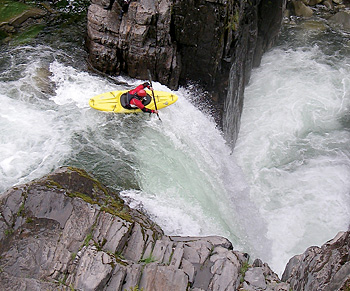
Staring through the spray at one of California’s most epic kayak runs
By Seth Lightcap
Photo: Don Beveridge
Eric Strittmatter lines up for the first of two consecutive 50-footers at Heath Springs.
For such a benign particulate substance a water molecule sure does pack a punch when it’s rolling with a posse. Collect and confine them in a steep canyon and the power of the assembled molecules can be more intimidating than any gang that ever walked the streets.
The upper stretch of the North Fork of the American River, the Royal Gorge, is one such chasm where water has ruled with an iron fist for generations. Until the most recent one, that is, when a few brave and talented boaters have tamed – or at least lived to tell about – its furious gravitational forces.
Although it drains a million acres of Sierra crest snowpack backing up to the North Tahoe ski resorts of Sugar Bowl and Squaw Valley, the headwaters of the North Fork lie at about 8500 feet, not especially high, which means its boating season is shorter than many other Sierra rivers – stretching from spring into early summer in wetter years.
But what the river lacks in seasonal length, it makes up for in punch. Early surveyors didn’t decide to name the top portion of the North Fork, a cleft in the earth up to 4000 feet deep, the “Royal Gorge” for its aristocratic nature.
The continuous churn of water grinding through the craggy Sierra bedrock has created an unruly river that plummets at an average of 195 feet per mile through a 16-mile chasm, losing elevation in large and sudden doses, as in waterfall after waterfall, a half dozen in excess of 50 feet.
Now California is home to numerous world-class runs, both extreme and less so. But the Royal Gorge cataract, with its eye-popping falls and countless chewy Class V rapids, has been called by the growing handful of elite kayakers that have paddled it as one of the finest and most beautiful Class V+ runs on this green earth.
That it’s even considered runnable is testament to just how far whitewater kayaking has come. None of California’s pioneering paddlers of the ‘70s, ‘80s or early ‘90s would attempt it. Not until 1998 was the Royal Gorge christened by paddlers, when a team consisting of famed boaters Scott Lindgren and Tao Berman, as well as Dean Cummings, Clay Wright and Tom Waclow, tested its plumbing.
Although it’s seen descents by dozens of bold boaters since, its burly reputation has barely budged. Broken paddles, broken bodies, lost boats, scary portages, trespassing tickets – it’s become legendary for all that and more. But as the crew found in 1998, there is an honest-to-god runnable waterway lurking in that gorge parallel to and just a few miles south of Interstate 80 from Donner Summit. You just gotta have the skills and the moxie to grease the challenge.
Picking the right water volume is the first critical decision of making this three-day, 40-mile run (16 miles of Royal Gorge plus 24 miles on the Generation Gap and Giant Gap runs). According to Lindgren, who appropriately enough pioneered the Royal Gorge stretch since it’s practically in the backyard of his hometown of Auburn, 1000 cfs is ideal. But catching that flow with the access road plowed to the put-in can be tough some seasons.
If you do find the put-in bridge, don’t worry about a trespassing ticket. “There is no Royal Gorge access controversy,” Lindgren told ASJ in March. “The access is a public road to a public bridge. After our trespassing problems in 1999 we had a lawyer battle with the North Fork Association whose land the road runs through. They ended up dropping the charges and the case got thrown out before it went to court.”
“A year round NFA caretaker might harass you, but he has no legal right nor jurisdiction to stop you,” Lindgren added. “The road is a public road. Period.”
Though Johnny Law won’t stop you, a deep snowpack might. In 2007, a foursome of kayakers that included James McLeod and Jared Noceti of Sacramento found an answer to that problem, however.
“The road was still snowed in so we rallied our mountain bikes down to the put-in dragging our boats behind us,” McLeod says. “We locked them up hidden in the woods and came back for them a month later when the road had opened.” (See video of their bike-n-boat mission under “Royal Gorge” at broadbandsports.com)
Once in the river the freakish fun begins straight away at the Heath Springs waterfalls, two consecutive 50-footers. Not looking to huck at Heath Springs? Watch out for the portage, says Shannon Carroll, the former women’s waterfall world record holder.
“If you don’t want to paddle the Heath Springs waterfalls you end up having a big portage to put back in just above the crux gorge,” says Carroll. ”Watching guys scramble down the mountain side with kayaks on that portage was probably the scariest part of the trip. A piece of rock broke loose and landed on a kayak knocking it into the river. I’ve never seen kayak boys move so quick. Had we lost a boat there we would have been, well … up the creek without a boat. Craziness.”
After Heath Springs the river drops into the crux rapid, a mandatory paddle.
“When you run these amazing rapids there is something about being isolated in the deep dark granite corridor,” says McLeod. “It brings a heightened awareness to every paddle stroke, every moment, all of your senses are turned up a notch.”
The three other classic falls of the run are Rattlesnake Falls, Scott’s Drop, and Wabena Falls.
Scott’s Drop was first run by Lindgren, of course. It took seven years for a second descent.
“My drop is a 45-footer into a 50-foot slide,” says Lindgren. “It’s pretty technical paddling and gets portaged frequently. There are rumors that I didn’t scout it before running it, but that’s not true. I scouted it as much as I could from the top.”
Rattlesnake Falls at 50-plus feet is next. Carroll recalled the last time she ran it:
“By the time we got to Rattlesnake two people had broken paddles so if anyone broke another on the falls they’d be faced with a steep and arduous hike out with their boat. I chose to run the falls anyway and stuck with my ‘feather technique’ – I tuck the paddle alongside the boat as I drop so that it feathers into the water on entry. Works every time.”
“But other people began getting creative,” Carroll laughed. “Some of the guys tossed their paddles at the top of the drop. Worked for a few, but tossing his paddle caused one guy to drop awkwardly and eject from his kayak on impact. Extracting the boat from the eternal eddy recirculating at the bottom of the drop was quite the rescue mission. The paddler was fine though.”
The proverbial last-but-not-least is Wabena Falls (elev. 3,800 feet), the biggest waterfall on the run – a “no-brainer,” Lindgren claims, because it’s a “70-foot vertical waterfall into a nice calm pool.”
The drop is the finale of the 16-mile Royal Gorge stretch as the next North Fork section, Generation Gap, a stout 10-mile Class V run in its own right, begins, followed by the slightly easier 14-mile Giant Gap run.
If you’re tempted by the Royal Gorge, you’d better be an extremely talented and confident boater for there is good reason it is not profiled in any guidebooks or on any whitewater websites. Running the gorge is a deadly serious and sustained multi-day adventure. There’s no shortage of opportunity for something to go wrong. And unless you’re packing a Satellite phone, help is not on the way.
“Running the Royal Gorge you feel very vulnerable,” says Carroll. “There’s no one that can help you out there. It is you and your crew versus the elements. That’s why it’s always good to be with a group of people you trust. You want to be confident that everyone will make good decisions for themselves and do all they can to help rescue someone if need be.”
But sometimes the reward is worth the exposure.
“Within a few steep rapids and drops you are completely engulfed in a magical, seemingly other worldly paradise of cedars and granite,” says McLeod. ”And you know full well that there is another 39 miles of Sierra gnar before you will see another road. It’s like paddling down a mountain side.”
“The Royal Gorge is a gem,” adds Lindgren. “There is no doubt about it. It’s as good as it gets.”

